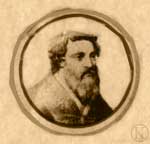POPE NICHOLAS IV
192ND Pope (1288-1292)

Home
Kolbe Library
Annals of Catholicism
(GIROLAMO MASCI)
Born at Ascoli in the March of Ancona; died in Rome, 4 April, 1292. He was of humble extraction, and at an early age entered the Franciscan Order. In 1272 he was sent as a delegate to Constantinople to invite the participation of the Greeks in the Second Council of Lyons. Two years later he succeeded St. Bonaventure in the generalship of his order. While he was on a mission to France to promote the restoration of peace between that country and Castile, he was created cardinal-priest with the title of Santa Pudenziana (1278) and in 1281 Martin IV appointed him Bishop of Palestrina. After the death of Honorius IV (3 April, 1287), the conclave held at Rome was for a time hopelessly divided in its selection of a successor. When fever had carried off six of the electors, the others, with the sole exception of Girolamo, left Rome. It was not until the following year that they reassembled and on 15 February, 1288, unanimously elected him to the papacy. Obedience and a second election however (22 February) were alone capable of overcoming his reluctance to accept the supreme pontificate. He was the first Franciscan pope, and in loving remembrance of Nicholas III he assumed the name of Nicholas IV.
The reign of the new pope was not characterized by sufficient independence. The undue influence exercised at Rome by the Colonna is especially noteworthy and was so apparent even during his lifetime that Roman wits represented him encased in a column — the distinctive mark of the Colonna family — out of which only his tiara-covered head emerged. The efforts of Rudolf of Habsburg to receive the imperial crown at the hands of the new pope were not successful. His failure was partly due to the estrangement consequent upon the attitude assumed by the pope in the question of the Sicilian succession. As feudal suzerain of the kingdom, Nicholas annulled the treaty, concluded in 1288 through the mediation of Edward I of England, which confirmed James of Aragon in the possession of the island, He lent his support to the rival claims of the House of Anjou and crowned Charles II King of Sicily and Naples at Rieti, 29 May, 1289, after the latter had expressly acknowledged the suzerainty of the Apostolic See and promised not to accept any municipal dignity in the States of the Church. The action of the pope did not end the armed struggle for the possession of Sicily nor did it secure the kingdom permanently to the House of Anjou. Rudolf of Habsburg also failed to obtain from the pope the repeal of the authorization, granted the French king, to levy tithes in certain German districts for the prosecution of the war against the House of Aragon. When he appointed his son Albert to succeed Ladislaus IV of Hungary (31 August, 1290), Nicholas claimed the realm as a papal fief and conferred it upon Charles Martel, son of Charles II of Naples.
In 1291 the fall of Ptolemais put an end to Christian dominion in the East. Previous to this tragic event, Nicholas had in vain endeavoured to organize a crusade. He now called upon all the Christian princes to take up arms against the Mussulman and instigated the holding of councils to devise the means of sending assistance to the Holy Land. These synods were to discuss likewise the advisability of the union of the Knights Templars and Knights of St. John, as the dissensions among them had partly caused the loss of Ptolemais. The pope himself initiated the preparations for the crusade and fitted out twenty ships for the war. His appeals and his example remained unheeded, however, and nothing of permanent value was accomplished.
Nicholas IV sent missionaries, among them the celebrated John of Montecorvino (q. v.), to the Bulgarians, Ethiopians, Tatars, and Chinese. By his constitution of 18 July, 1289, the cardinals were granted one half of the revenues of the Apostolic See and a share in the financial administration. In 1290 he renewed the condemnation of the sect known as the Apostolici (q. v.). Nicholas was pious and learned; he contributed to the artistic beauty of Rome, building particularly a palace beside Santa Maria Maggiore, the church in which he was buried and where Sixtus V erected an imposing monument to his memory.
|



